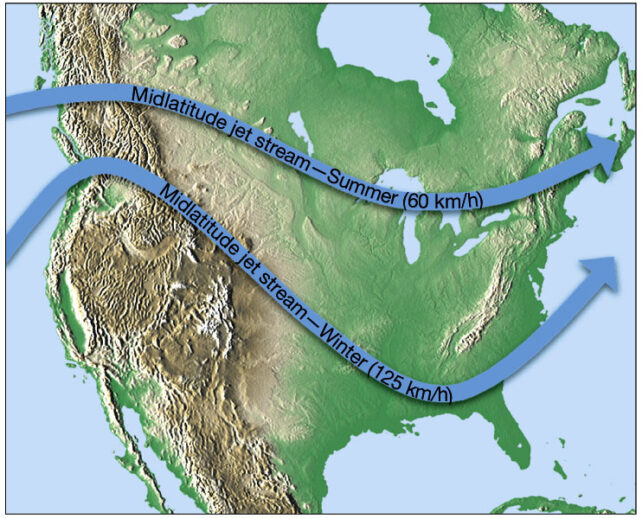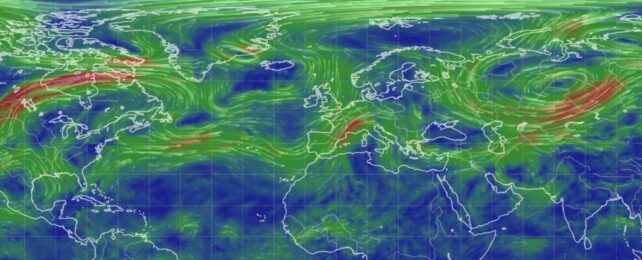The currents of air that wrap around our planet are becoming unrecognizable to climate scientists.
Some have even compared the chaotic pattern of the jet streams to a Van Gogh painting.
The southern part of the jet stream over North America has completely broken apart and is currently trapped in a vicious revolution that has triggered an off-the-chart heatwave.
While it's normal for the air currents to stop, split apart, recombine and flow in opposite directions, on average these tropospheric air streams are typically continuous over long distances with an overall west to east flow.

The current fragmentation is unlike anything specialists have seen before.
"When I look at this jet stream the word insane comes to mind," tweeted the chief meteorologist of a local Florida news station, Jeff Berardelli.
"This configuration, likely enhanced by climate heating, is fueling a record heat dome so extreme that even experts are astonished!"
I'm honestly at a loss to even characterize the current large-scale planetary wave pattern. Frankly, it looks like a Van Gogh https://t.co/NJmN54vC27 pic.twitter.com/xLtBLRZxFi
— Prof Michael E. Mann (@MichaelEMann) June 20, 2023
The climate scientist and author Michael E Mann was quick to reply to Berardelli's tweet. Mann has studied planetary wave behavior for years now, and yet online he said that he's rarely seen "such a disjointed configuration."
Jet streams are known to get 'blocked' on occasion, trapping weather systems in certain regions for days on end. But recent evidence suggests climate change could cause more blockages than usual by slowing down jet streams so they break apart, causing chaotic weather on the ground.
That seems to be what's happening right now in North America, and it's not just climate change that's contributing.
Mann explains that El Niño has likely exacerbated the situation, too.
"I'm honestly at a loss to even characterize the current large-scale planetary wave pattern," he tweeted.
Even the average layperson can clearly see the differences when comparing a normal pattern of jet streams to what's occurring today.

At the moment, Mann describes the jet streams over North America as "slow and wobbly", which is probably a result of climate change.
Last year, a study found warming temperatures in the Arctic were specifically weakening jet streams in the Northern Hemisphere.
What's more, because of El Niño, the paths of these jet streams have also changed latitude, exposing the southern regions of the US to the heat dome.
In the United States alone, 40 million people are currently under high heat alert, and in the last week, there have been widespread power outages.
The center of the heat dome sits over Mexico and has already caused a mass death of birds.
The climatologist Maximiliano Herrera apparently told Berardelli that the heat wave in some parts of Mexico is like a "category 7". Category 5 is the highest actual ranking on the heat index scale, defined as "beyond extreme" heat.
Herrera is essentially arguing we're now beyond previous extremes.
"[I]t's simply something in its own league, nothing like this even can attempt to compare," Herrera is quoted as saying. "Records obliterated all over with insane margins and beaten as many as 7 days in a row."
Nor is there a sign of the heatwave ending any time soon. Some experts think the dome could stick around until July.
In the past, strange jet stream patterns in Earth's atmosphere have coincided with extreme weather events in both the northern and southern hemispheres, although usually not in both at the same time.
Right now, though, even the southern hemisphere's jet streams look out of whack, experts note.
This version is a bit clearer IMO. Even the Southern Hemisphere jet seems particularly wavy, perhaps related to the record-low sea ice there: pic.twitter.com/lfuv9t72yj
— Dr. Jennifer Francis (@JFrancisClimate) June 21, 2023
This week in southern Australia, for example, a jet stream is bringing unusually wet weather to some regions of the nation.
And back up North, the Atlantic hurricane season is starting to brew months early, University of Miami climatologist Brian McNoldy warns.
Meanwhile, sea surface temperatures have also soared into uncharted territory, and don't seem to be returning to normal levels any time soon. This has already caused mass fish deaths and marine mammal poisonings and all before the El Niño has properly set in.
"It is now clear that Earth's climate system is way out of kilter and we should be very concerned," Central Queensland University Environmental Geographist Steve Turton explained for The Conversation.
From pole to pole, the winds of change are here. The climate crisis is no longer a future problem. It's happening now, right before our eyes.
